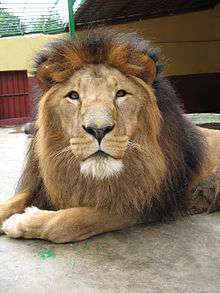Ethiopian lion
| Ethiopian lion | |
|---|---|
 | |
| A male Ethiopian lion in Addis Abeba Zoo, 2006. | |
.jpg) | |
| A lioness or cub in Addis Abeba Zoo, 2012. | |
| Scientific classification | |
| Kingdom: | Animalia |
| Phylum: | Chordata |
| Clade: | Synapsida |
| Class: | Mammalia |
| Order: | Carnivora |
| Suborder: | Feliformia |
| Family: | Felidae |
| Genus: | Panthera |
| Species: | P. leo |
| Subspecies: | P. l. roosevelti |
| Trinomial name | |
| Panthera leo roosevelti (Heller, 1913) | |
The Ethiopian lion (Panthera leo), also called "Addis Ababa lion" or "Abyssinian lion, is a captive lion population in the Addis Abeba zoo.[1]
In 2016, a group of lions was recorded in Ethiopia's Alatash National Park.[2][3][4]
Taxonomic history and genetics
In 1914, the American zoologist Heller described the Ethiopian or Abyssinian lion under the name Felis leo roosevelti on the basis of a male lion presented to President Roosevelt, allegedly from the vicinity of Addis Abeba.[5]
A DNA analysis was conducted on fifteen lions in the zoo, to six populations of wild lions, by a team of researchers led by the Max Planck Institute for Evolutionary Anthropology in Germany, and the University of York in the United Kingdom. The results showed little signs of inbreeding, and that they were genetically unique. Their uniqueness was shown from a comparison of their mitochondrial Cytochrome B (CytB) gene sequence, to sequences of wild lions of different origins.[1]
Characteristics
Compared to other African lions, Ethiopian lions have darker manes and smaller bodies.[1] However, the physical differences to wild lions may be due to their living in captivity, which can affect a lion's physical appearance. Abyssinian lions appeared to have been bigger and thicker-maned than lions in Somalia, but smaller than the Cape lion. Manes of Ethiopian lions were described as black and thick, similar to those of Cape lions, except that they did not extend through the flanks.[5]
Possible origin or habitat
Ethiopian authorities stated that the zoo's lions resembled lions in the eastern and northeastern parts of the country, in Babille Elephant Sanctuary, and in a facility for rescuing wildlife in Ensessakotteh. The lions of the zoo belonged to the zoo's founder Haile Selassie, who founded it in 1948. Their origin in the wilderness is not known. One theory is that they may have descended from seven lions, five males and two females, which originated in the southwestern part of the country, and that wild lions no longer exist there, because their dark manes made them visible to hunters.[1]
See also
References
- 1 2 3 4 Bruche, S.; Gusset, M.; Lippold, S.; Barnett, R.; Eulenberger, K.; Junhold, J.; Driscoll, C. A.; Hofreiter, M. (2012). "A genetically distinct lion (Panthera leo) population from Ethiopia". European Journal of Wildlife Research. 59 (2): 215–225. doi:10.1007/s10344-012-0668-5.
- ↑ "Lions rediscovered in Ethiopia's Alatash National Park". BBC News. 2016. Retrieved 1 February 2016.
- ↑ Howard, B. C. (2016). "Once Thought Extinct, 'Lost' Group of Lions Discovered in Africa". National Geographic. Retrieved 2016-02-07.
- ↑ Wong, S. (2016). "Hidden population of up to 200 lions found in remote Ethiopia". New Scientist. Retrieved 2 February 2016.
- 1 2 Heller, E. (1913). New races of carnivores and baboons from equatorial Africa and Abyssinia Smithsonian Miscellaneous Collections 61(19): 1–12.